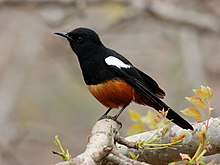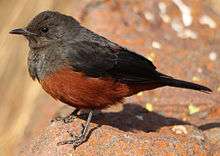Mocking cliff chat
The mocking cliff chat, mocking chat or cliff chat, (Thamnolaea cinnamomeiventris) is a species of chat in the family Muscicapidae which occurs in rocky habitats in much of eastern Sub-Saharan Africa.
| Mocking cliff chat | |
|---|---|
 | |
| Male in South Africa | |
 | |
| Female in South Africa | |
| Scientific classification | |
| Kingdom: | Animalia |
| Phylum: | Chordata |
| Class: | Aves |
| Order: | Passeriformes |
| Family: | Muscicapidae |
| Genus: | Thamnolaea |
| Species: | T. cinnamomeiventris |
| Binomial name | |
| Thamnolaea cinnamomeiventris (Lafresnaye, 1836)[2] | |
| Synonyms | |
| |
Description
The mocking cliff chat is a large chat with distinctive colouration. The male has a glossy black with a chestnut belly, vent, and rump and white shoulder patches. The shoulder patches vary in size geographically. The female is dark grey with a chestnut lower breast, belly, and vent.[3] The mocking cliff chat has a length of 19–21 cm and weigh 41–51g.[4]
Distribution and movements
The mocking cliff chat occurs in a neat band from central Ethiopia in the north through east Africa into Zimbabwe, south-eastern Botswana, southern Mozambique and eastern South Africa as far as the far east of Western Cape province. Mostly resident but in the south of its range tends to move to lower altitudes in the winter months.[6]
Habitat
The mocking cliff chat inhabits rocky and boulder strewn areas, well-wooded rocky ravines, cliffs, gullies, boulder-strewn hillsides and watercourses in valley bottoms with scattered rocks.[6]
Habits
The mocking cliff chat is mainly insectivorous but also eats fruit and feeds on the nectar of aloes, such as the Krantz aloe Aloe arborescens. It chief foraging technique is to pounce on food on the ground from a perch bit it will also glean food from branches and foliage.[6] The habitually wag their tails, slowly raising over their backs and fanning it out.[5]
Both sexes build the nest, taking about a week to construct an open cup built over a foundation of twigs, leaves, roots and feathers and lined with the hair of mammals. They often use the nests of striped swallows frequently evicting the swallows while they are still using the nest. The nest is usually positioned below a rock overhang, bridge, culvert or in a cave and it may sometimes be placed in a hole in a wall or in a cavity in agricultural machinery. In southern Africa the eggs are laid from August–December, with a peak during September–November. The normal clutch size is 2-4 eggs, which the females incubates for about 14–16 days. Both parents feed the chicks which fledge at about three weeks old.[6]
Taxonomy
There are six currently recognised subspecies[2][4]
- Thamnolaea cinnamomeiventris kordofanensis Wettstein, 1916: Nuba Mountains, in central Sudan.
- Thamnolaea cinnamomeiventris albiscapulata (Rüppell, 1837): northern Eritrea and northern, central and eastern Ethiopia.
- Thamnolaea cinnamomeiventris. subrufipennis Reichenow, 1887: eastern South Sudan and south-western Ethiopia south through the Rift Valley and Tanzania to eastern Zambia and Malawi.
- Thamnolaea cinnamomeiventris odica Clancey, 1962: Eastern Zimbabwe.
- Thamnolaea cinnamomeiventris cinnamomeiventris (Lafresnaye, 1836): Eastern Botswana, eastern South Africa, western Swaziland and Lesotho.
- Thamnolaea cinnamomeiventris autochthones Clancey, 1952; Southern Mozambique south to north-eastern South Africa and eastern Swaziland.
The white-crowned cliff chat (Thamnolaea coronata) of West Africa is sometimes included in this species.[4]
References
- BirdLife International (2012). "Thamnolaea cinnamomeiventris". IUCN Red List of Threatened Species. 2012. Retrieved 26 November 2013.CS1 maint: ref=harv (link)
- "Thamnolaea cinnamomeiventris (Lafresnaye, 1836)". Integrated Taxonomic Information System (ITIS) (https://www.itis.gov). Retrieved 2016-11-20.
- Ian Sinclair; Peter Ryan (2003). Birds of Africa south of the Sahara. Struik. pp. 472–473. ISBN 1 86872 857 9.
- "Mocking Cliff-chat (Thamnolaea cinnamomeiventris)". HBW Alive. Lynx Edicions. Retrieved 2016-11-20.
- Zimmerman, Dale A.; Turner, Donald A.; Pearson, David J. (1996). Birds of Kenya and Northern Tanzania. Helm. p. 548. ISBN 0-7136-3968-7.
- "Thamnolaea cinnamomeiventris (Mocking cliff-chat, Mocking chat)". Biodiversity Explorer. Iziko Museums of South Africa. Retrieved 2016-11-20.
External links
- Mocking cliff chat - Species text in The Atlas of Southern African Birds.
- Recordings at Xeno-Canto
